#econlive
Text
Matthew Stank ID#94688618
Yuvraj Chera ID#53672029
0 notes
Text
Competitive Market and Business Choice.
Name: Shubing Zhou
ID: 52531404
Starting from the pandemic, people’s demand for services and goods has increased. Due to the impact of the pandemic, many restaurants shut down because of the negative profits they experienced. This has led to a problem in my hometown; there are not enough restaurants to meet the demand for dining out. For the businesses that survived the pandemic, they now have lines of customers on a daily basis. This has attracted more businesses to try to open restaurants in this city. My family is one of them, attracted by the opportunity to open a restaurant due to the significant profits brought about by the post-pandemic influence.
My mother, as the restaurant owner, decided to establish this as a breakfast restaurant, the first and only restaurant around the neighborhood. She discovered numerous job opportunities in the vicinity, and the locals had a penchant for having breakfast before heading to work. Given that my family already owned the premises and didn't need to pay rent to start this venture, the fixed costs were significantly lower. In light of this advantage, my mother opted to set menu prices similar to those of another breakfast spot in a nearby city, although is slightly higher. With no competition around the area, it makes this breakfast place popular and most people would still come even after slight price increases. Since the breakfast market in this city is limited, customers faced with the choice between driving 30 minutes to a neighboring restaurant or paying slightly more at our location generally opted for the latter. For many workers in the area, the opportunity cost of traveling to a distant breakfast place outweighed the extra expense at our store. Consequently, they preferred to stay and have breakfast at my mother's establishment.
However, even though this is a free market, my mother wasn't the only one who recognized the profitability of operating a breakfast place in the city. After three months, a new breakfast establishment opened just three blocks away from my mother's restaurant. Consequently, the market became competitive, with customers selecting their breakfast spot based on price. The two businesses now compete on menu prices, with the one selling at a lower price attracting more demand from customers and making more money. Initially, my family managed to earn a profit from the business because their prices were higher than the average total cost. However, with the entry of another firm into the market, they began to engage in price competition, driving prices down close to our average total cost for daily operations. After four months of competition, my family found themselves operating the business at a zero-profit line, where sales generated no profit for us. Despite this, my family chose to persevere, hoping that another business might exit the market. Nearly a year later, more breakfast places had opened in the city, and most were selling at similar prices. By this time, the breakfast market had become a free market where individuals cannot impact the market price. However, due to inflation in ingredient costs, my family was now experiencing negative profitability from the business. Another two months later, my family made the decision to close down the business because they couldn't find a way to cover the costs of inflation or compensate for the loss of customer demand if they raised prices for breakfast. The opportunity cost of exiting the market includes the potential future gains of the business and the equipment costs invested in the store if those haven't been recouped by the time of closure. On the other hand, if they choose to continue operating, the opportunity cost becomes the potential negative profit they might incur and the monthly operational expenses of the business. My family's decision serves as a clear illustration of the workings of a free market, where if the incurred losses outweigh the potential profits of sustaining the business, exiting the market becomes the rational choice. Consequently, the market ends up populated only by businesses earning zero or positive profits.
0 notes
Text
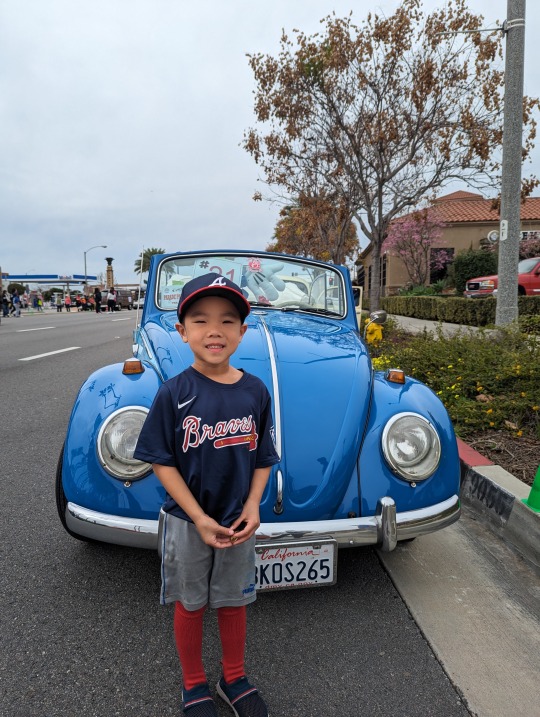
I take my son to preschool everyday and currently, he really likes nursery rhymes. The Wheel On The Bus is his favorite, which means I have to play it a lot in the car, which then means that the song gets stuck in my head. I was thinking about this project while driving him to preschool and I guess the two things merged together. I changed the lyrics to The Wheel On The Bus to reflect some of the principles of microeconomics that I use in my daily life. I am not a good singer, so I forced my husband to sing what I wrote. These are the lyrics:
Incentive is something that makes people act. This concept, is not abstract.
I use it everyday with my two brats. All day long!
Whenever they do things they're supposed to do. Say thank yous, homework too.
They get tickets in which they choose to. Trade for loot!
Now my kids to not have to fight. They compromise, and specialize.
Trade has made us better off. In my eyes.
There's no such thing as free lunch. Trade tickets, for fruit punch.
You want new stuff but can't pay up. That's credit crunch.
The fancy toys cost a fortune. This is a, situation.
For my kids to think about. The margin.
At days end I am their mom. So I help, fix outcomes.
Which makes me the government. I hope I don't fail.
Wei Sun Chiu
ID: 80164694
Monday section 2:00-2:50PM
1 note
·
View note
Text
Opportunity Cost During Covid-19
In March of 2020 was when the pandemic had started to really take a toll in Southern California. In my sophomore year of high school, my school suddenly called for a “two-week break”, so the whole school had to adjust to online learning in just a few days. For the rest of the 2020 school year and into the 2021 school year, a lot of my friends were sad about having to do classes on Zoom without being able to see their friends in person, I personally loved doing class in bed a minute after waking up. A lot of the times, turning on our cameras and verbally participating was not required.
The reason why I bring this up about Covid is the idea of opportunity cost. In my junior year of high school was when I took AP English Language and Composition (AP Lang.) and AP US History (APUSH) and 4 other non-AP courses. The question I asked myself every morning was whether I wanted to wake up and actually pay attention to the teacher or if I wanted to log into Zoom and then just sleep through all of class. The opportunity cost of actually paying attention to the teacher was more time to sleep and then not doing so well on the AP tests, and the opportunity cost of sleeping through my classes was actually understanding the lessons and acing the AP tests. This was not the only question I asked every day. Every day, I also decided whether or not I wanted to do my homework or watch Youtube at night, whether I wanted to sleep early or stay up watching Korean drama, or whether I wanted to actually do the homework myself or look for answers online/getting answers from my friends.
Sadly, I chose to do a majority of my classes in bed and not pay attention to what the teacher was saying, leading to my not-so-high AP scores.
All to say, opportunity costs does not apply to student life during the Covid pandemic, but I still make choices and weigh the different opportunity costs in my every day life.
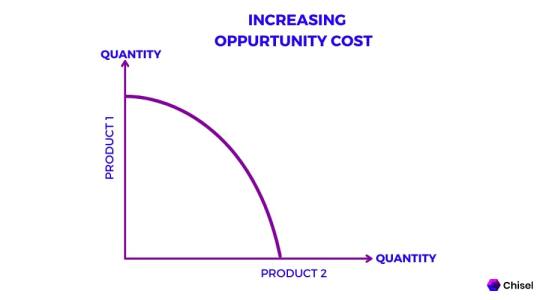
Source: Chisel Labs
Name: Janice Ji
ID: 15806404
0 notes
Text
Econ Live: Opportunity Cost
Econ Live Project: Opportunity Cost
Jaida Vue(41995496), Ahtziri Meneses (71706366)
Monday 3-3:50pm
This is the link to our presentation: https://www.canva.com/design/DAF_K2c5cA4/Hjdqo8_iECnLr92xzHoaYg/edit?utm_content=DAF_K2c5cA4&utm_campaign=designshare&utm_medium=link2&utm_source=sharebutton

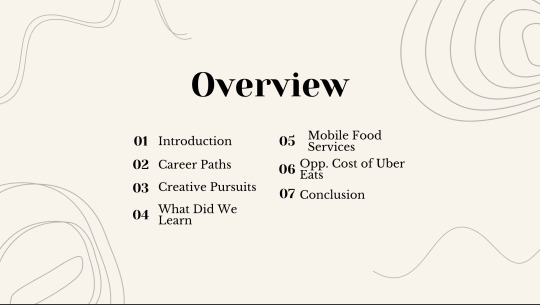
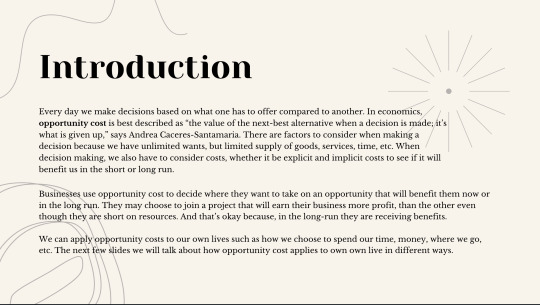
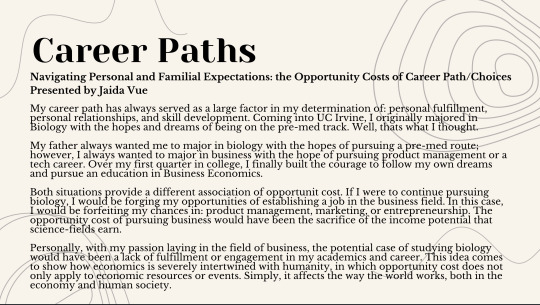
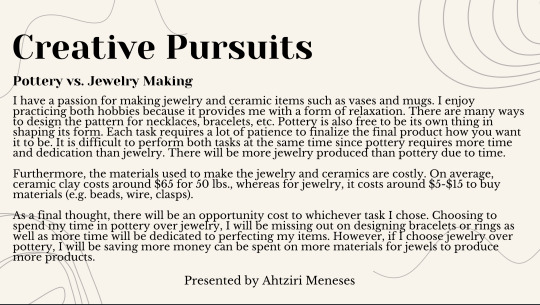
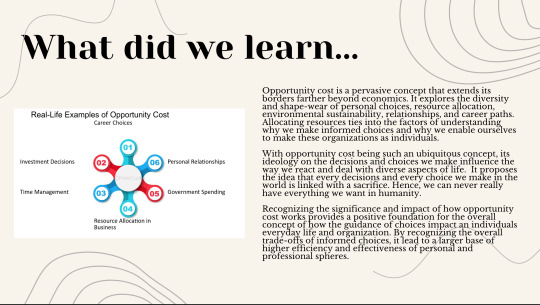
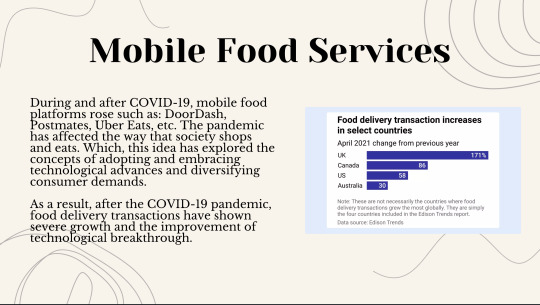

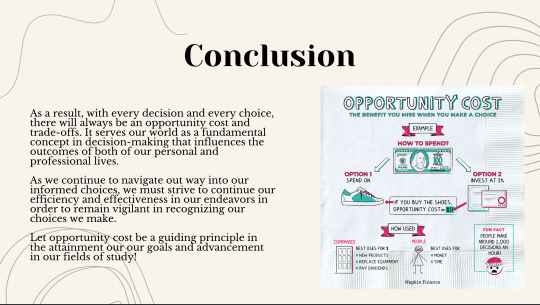

0 notes
Text
Opportunity Cost and Preferences In the Daily Life of a University Student.
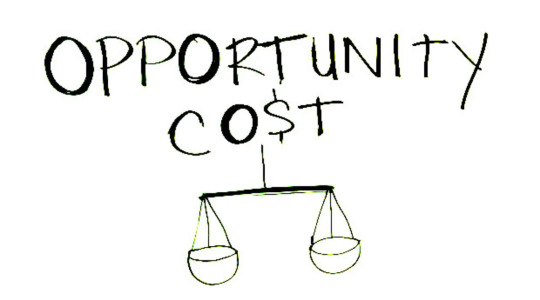
What exactly is opportunity cost?
Opportunity cost is the potential benefits that an individual or a business misses out on when choosing one alternative over the others. Opportunity cost is not just a fundamental concept in economics, but it is also a prominent component that dictates our everyday lives.
In your daily life, you are constantly confronted with decisions and choices, such as waking up early to attend lectures or sleeping in and watching recorded lectures later. This decision can lead to different outcomes and influence how your day is going to be. Sleeping in means that your day starts later and you have less time to accomplish what you set out to do that day, which can lead to you sleeping late and waking up later the next day just to repeat the same process until you decide to wake up early. This highlighted the concept of opportunity cost and its influences on other decisions/outcomes of your life.
I will now discuss the decisions made and the opportunity cost of my usual daily routine on a Friday. (These decisions are based on the choices that I made today at the time I am doing this project.)

On Friday, I have classes from 10:00 am- 2:00 pm and I tend to wake up around 6:30 am to eat and workout at the gym before going to class. This is the first opportunity cost that I faced.
Wake up early, eat, and work out.
Sleep in and work out later in the afternoon.
I decided to wake up early at the cost of some more sleep. However, if I chose the latter, I would have to make up for the missed gym session and spend time later to work out, costing me time that I could otherwise use to study for doing things that I enjoy. If I decided not to work out entirely that day, I would then be disappointed in myself. This illustrated the ideas of how decisions and opportunity costs can snowball into other effects that can further influence your day.
After working out, I have 3 options:
Cut the workout session short to shower and head to class.
Go home, shower, and head to class late.
Go the class and shower later.
I chose to shower and be late for class. The opportunity cost here is that I would miss out on some important information that the professor said at the beginning of the class. However, I can ask a friend to relay that information to me. So, there aren't any opportunity costs of being late to class aside from the guilt of walking in late.
After the lecture, have a gap period before a lab and I can choose between 2 options:
Relax by eating and watching YouTube.
Eat after I get home from lab and do homework.
But no one like to do homework so I often choose to relax before lab. From choice, I get to enjoy my time and the trade-off is I have to do my homework when I get home later, lessening my free time at home.
After lab, I have 3 options:
Be proactive and stay on campus in the library to complete homework.
Go home and rest.
Hang out with friends.
Going out with friends here would mean that I lose the time that I can rest and do homework as well as the money that I am going to spend while out with them. However, nothing is more important than some good quality time with friends so I decided to do homework and rest can wait while I hung out with my friends.
While going out, we got hungry and decided to find a place to eat. We narrowed it down to 3, In and Out, Korean BBQ, and ramen. We then decided what to eat by voting. I prefer In and Out over Korean BBQ, Korean BBQ over ramen, and In and Out over ramen. The trade-off of my preferences is that In and Out is cheaper but it is the farthest from where we were. Thus, the opportunity cost of my choice is that I would have to spend more time traveling further and in return, I save money to use it elsewhere. On the other hand, my friends all agree that they prefer In and Out over ramen, Korean BBQ over In and Out, and ramen over Korean BBQ. However, this preference is irrational (not transitive) as they contradicted themselves by liking ramen, their supposed worst option over Korean BBQ, their supposed best option. As a result, I was able to convince them to go to In and Out.
After the fun, I looked at the clock and it was already 8:00 pm and I hadn’t even started my homework assignments. So I hurried back home and started working immediately. This is the opportunity cost of my decision to eat and rest during the break on campus and hang out with friends afterward. As a result, I have to rush my homework, putting stress on myself and potentially getting a bad grade on the assignments. So in the end, I trade fun for stress as the opportunity cost of previous choices.
Now it is midnight, and I can either choose
Think about my mental health and sleep early.
Sleep late and be tired the next day.
And of course, like any college student, I decided to sleep late as it was the weekend after all. Staying up late allows me to catch up on video games while sacrificing my sleep which I would eventually regret when waking up the next day.
In conclusion, opportunity cost is crucial in decision-making not just inside of the economic world but also in your daily life. Understanding that time is a limited resource and you need to decide how you want to spend it to maximize productivity and enjoyment.
Econ 23, Tuesday 7:00pm
Name: Quan Le
SID: 71725028
0 notes
Text
Econ Live Project: Drunk Elephant
Elisa Melendrez (89187978) , Talin Ovanessian (26663077), and Sharon Park (63584953)
Monday 3-3:50pm
1 note
·
View note
Text
Justin Lee (ID: 49048234)
My Econ Live in soccer market
Introduction
When we see the sports game, we may be curious about how players and clubs earn the money. We are able to check the difference about earning money between players who are professional and players who are either semi-professional or amateur. Not only players but also soccer clubs have different incomes. Among lots of soccer leagues in the world, this post concentrates on the famous soccer league in the English Premier League.
How players receive their annual salary or weekly wage
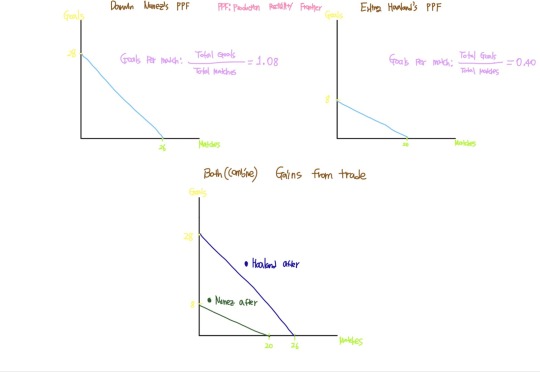
In the case of players, obviously players can get a chance when they have a good performance on the field and have many matches. For example, we will compare two star soccer players Erling Haaland and Darwin Nunez. Firstly, when we look at Haaland’s graph, he scored 28 goals in 26 matches, so his goal’s rate is 1.08. On the other hand, when we check Nunez’s graph, he scored 8 goals in 20 matches, so his goal’s rate is 0.40. According to the graph, we can know 2 facts: absolute advantage, and comparative advantage. Haaland has an absolute advantage better than Nunez because he can play more matches and get scores on the field. However, Haaland has the comparative advantage in getting scores and Nunez has the comparative advantage in playing matches. When we check Haaland’s value is 170 million euros and Nunez’s value is 70 million euros, these two players' values are appropriated.
How Soccer clubs earn their incomes
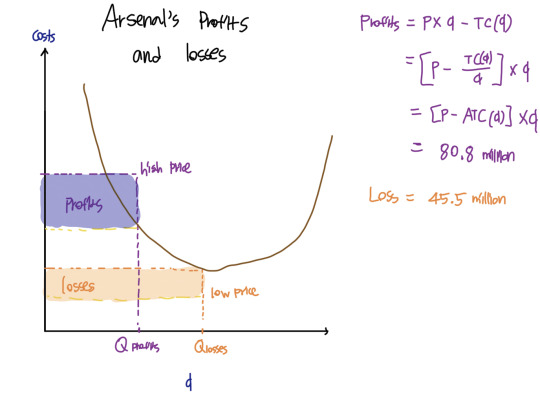
In the previous paragraph, it was explained about players’ salary and their profit. This paragraph will show how soccer clubs earn their incomes. For instance, we will check one on the biggest English club Arsenal. In the case of Arsenal, the profit was 39.5 million euros and the loss was 127.2 million euros in 2021. After a year, but, the profit was 80.8 million euros and the loss was 45.5 million euros. The change of profit and loss from 2021 to 2022 was positive since the profit was increasing and the loss was decreasing. Therefore, we can claim that Arsenal’s finances are stable and this club’s future is bright.
Conclusion
For these reasons, the incomes of soccer players and clubs are significantly higher than our expectation. In addition, if players and clubs are famous and have a good performance, the incomes could increase a lot.
1 note
·
View note
Text
Hashir Sheikh Econ Live Project
Hello, my name is Hashir Sheikh. I am a freshman and am majoring in business administration. I have a job while also being a full time student, working at In N Out. I will have been working there for about a year once summer hits, and as a worker for a big company, I always took note of their financial and economic strategies to both understand the world around me and improve my own understanding as I want to become a manager of a big company myself one day.
When I think about in n out, the first things to come to mind are the customer service, consistent quality, efficiency, and of course their low prices. When I think of a fast food establishment with all these categories to compare to In n out, what comes to mind is Chick fil A. The biggest difference of course, being the price. As both a customer and worker at In n Out, I have always wondered how they are so profitable with such low prices in this economy, but concepts in Econ 20A have helped me understand that, and as it is something that is a part of my life, I decided to do my project on the subject to truly understand it.
Lets see how drastic the price difference really is between chick fil a and in n out.
The average Chick-fil-A customer spends $15.91 per trip to the chicken chain, buying five items per trip. They make just 11 trips to Chick-fil-A each year, and they're most likely to buy
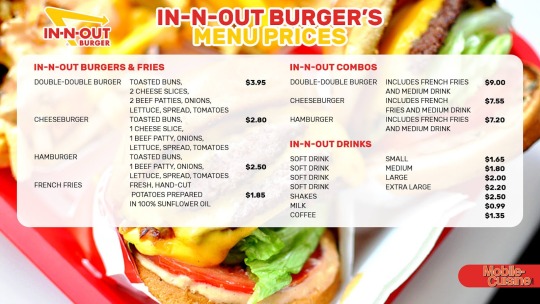
If you take In N Out’s highest priced combo at 9 dollars, that is around a 7 dollar price difference form what a customer spends on average at Chick Fil A. That could get you a whole other combo at in n out!
How does In N Out maintain this? How profitable really is it? These are some questions that come to mind when really taking a dive into the prices, the quantity, and comparing it to other stores. I have on various occasions had customers baffled that they are only spending 8 dollars tax included on their lunch or dinner at in n out considering prices nowadays. What I am going to do is bring up some concepts we learned this year in ECON 20A that give a really great understanding as well as some graphs.
Price effect: selling more lowers price on each unit. In n out is notorious for having long lines and packed drive thrus, so as they sell more, they are able to maintain low prices.
Output effect: selling more at price being greater than MC increases profit. In n Outs Marginal cost is less than their price, so as they sell more and more, their profit increases. Even though the prices are low, marginal cost is less.
This goes hand in hand with Economies of scale: when the average total cost decreases as quantity increases.
Price elasticity: measures how much quantity demanded responds to a change in price
Since In N Out has such low price, quantity demanded increases due to price elasticity. This also means In N Out has economies of scale because the total cost decreases as the amount sold increases. This means for every burger or fry they sell, the average cost will go down more and more no matter how small, making the profit margin greater and greater with each item sold. Quantity demanded in relation to price can also be seen in this graph:
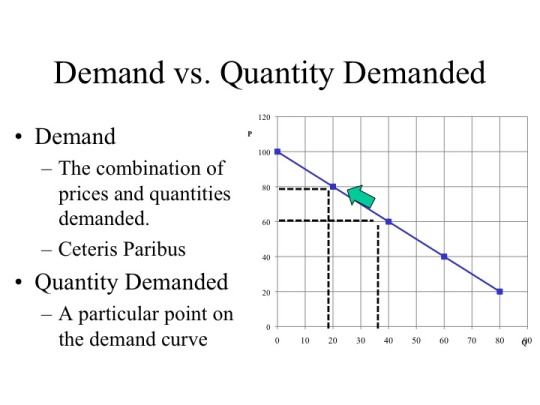
There is also The law of diminishing marginal utility: all else equal, as consumption increases, the marginal utility derived from each additional unit declines.
Instead of the low prices at In N out decreasing profit, they actually increase profit because of these economic explanations of Price effect, Output effect, Elasticity, economies of scale, etc. They have a very intelligent system and it makes sense why they are so succesful. Their consistent quality, customer service, and efficiency all go ahnd in hand with their intelligent low prices.
Thank you for reading!
1 note
·
View note
Text
How inflation affects grocery prices
Student Names & ID:
Aurash Azad: 81969644
Tayeh Ahadi: 46283688
Discussion Time: Thursday 7-7:50pm
Eggs:
In the past year, many groceries have seen an increase in prices due to several different factors, such as supply shortages, labor shortages, and natural disasters. In the latter category is eggs, which has had a 138% increase in price in the past year. Before, the average for a dozen Grade A eggs was approximately $1.79, but as of January of this year, the average price has gone up to $4.25. What could be the cause? For the most part, the rising price of eggs can be attributed to the avian bird flu that has swept the nation in the recent months, affecting close to 60 million birds, and as a result, their eggs. The bird flu has not only decreased the supply of eggs to the country, but also increased their overall prices. However, the high price of eggs doesn't detain all Americans, as they are considered a food staple to many, since they are used in a wide range of dishes, such as breakfast foods and baked dishes. The low supply of eggs coupled with their stable consumption means that in many grocery stores across America, eggs are completely sold out. Another source of high prices could be due to price gouging in major egg firms, such as Cal-Maine Foods, which has reported an increase of 600% in quarterly gross profit, though they haven’t had any cases of avian bird flu on their farms. Thus, although the egg industry has seen a decrease in supply due to the avian bird flu, a lot of the price increase is associated with large firms using the flu as an excuse to gouge prices in order to increase their profits, not thinking of the effects they may have on their consumers. In my personal experience, I use eggs frequently in my breakfast as they’re a quick and easy source of nutrition, and they’re versatile in a way that many other foods aren’t. Also, as a college student with very little income, eggs have served as a staple in my fridge since the beginning of university. However, in recent months, I have had to be more frugal in how I spend my grocery budget, and that means less eggs and healthy food options, and more cheap, low-quality food that’ll last me longer. However, even when I plan to buy eggs, they are not always available in my local grocery stores. Just recently, my trip to Trader Joe’s revealed empty rows where eggs used to be, as consumers continue to buy them even as their supply decreases. Eggs, though seemingly inconsequential in day-to-day life, play a significant role in many foods, and their price increase coupled with their supply shortage has resulted in distressing grocery trips all across the country.

Butter:
Grocery prices have been on the rise within the past few years. The COVID-19 pandemic that began March 2020 is only one reason to blame the skyrocketing prices, and the shortage of supply in the market. A shortage is when the quantity demanded is disproportionate and larger than the supply available at the market price. After the breakout of the pandemic, many of us would walk into grocery stores to see nothing left on the shelves. There are many different reasons for the rise of prices, and a few important ones that can be seen include shortages within labor as well as supply. According to the Time magazine, the price for one stick of butter has increased more than 31% just within the past year. The average price of butter was set at $3.47, and is now found to be $4.81 on average across most cities in the United States. Besides the COVID-19 pandemic, dairy farmers are blaming the extreme heat, along with the small cow herds, which includes the results of financial combats as the primary reason for the increase in the price for butter. The shortage of butter has caused major concerns in the US, not only for consumers, but for factories and productions as well. One of the main reasons for this is set due to milk production setbacks that occurred within the economy. The demand for butter is increasing, even as the rates for dairy production is lowering, which is causing a lower availability in the supply market. Besides the direct effect it has on the market industry, it affects the lives of individuals as well. For example, butter is an essential ingredient to both chefs as well as bakers, to almost everyone using it in the global economy. Most dishes around the world incorporate butter into their ingredients and are used to help melt or fry, complement, or enhance flavor. The cost of producing dairy products has widely increased and therefore has caused the supply to decrease. How has this affected my personal life? Well, here at UC Irvine it has been difficult living on campus, on a college budget and having to purchase groceries to cook meals. It has become more difficult due to the recent rise in grocery prices, but more specifically butter. Using butter is a crucial ingredient to many different dishes, including eggs, which have also seen inflation within the past few years. With the rise in prices and the decrease in supply available, it has been hard to get access to many basic grocery needs, including butter. Not only do I use butter to cook, but to bake as well. Whether it has been a cookie, cake, or any other dessert, one of the principle ingredients is butter and without it, it makes it very hard to bake or cook. Overall, the rise in grocery prices has caused a worldwide crisis in many households and has put no option but a budget to be imposed in many families that had never thought about having one before. However, with the COVID-19 pandemic emergency slowly coming to an end, along with the combination of farmers beginning to recover from the pandemic and fertilizer costs slowly beginning to decrease, we can anticipate that grocery prices, including the price of butter will begin to decrease once again.
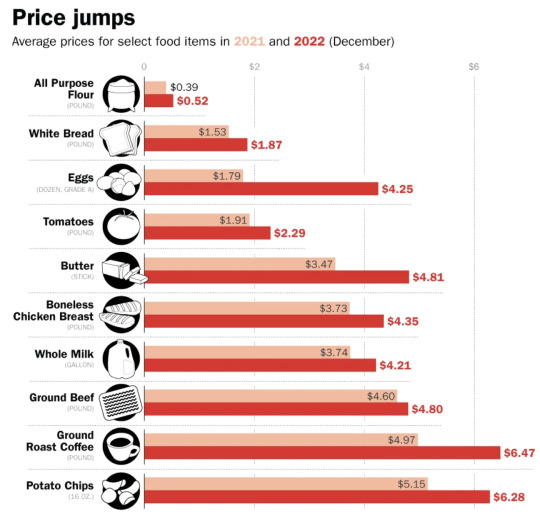
Sources:
0 notes
Text
Economics in Mahjong
Tuesday @ 8PM Discussion
Hello everyone!
Josh, Nathan, Jack, and I worked together for our Econ Live and decided to write about how economics plays a role in Mahjong. As Mahjong is something that we have all fell in love with this past quarter, we had lots of fun working on this project!
Here is the link to our Econ Live Project:
https://docs.google.com/document/d/1tIiQyyWuwy90cggpN35vaZcCTi3KYDDHrl1nALP-0bc/edit?usp=sharing
Name: Joshua Micah Sullivan (205/7887)
Name: Nathan Henry Ong (76719148)
Name: Jack Carver Wing (38178824)
Name: Leo Yan-Git Siu (14259367)
0 notes
Text
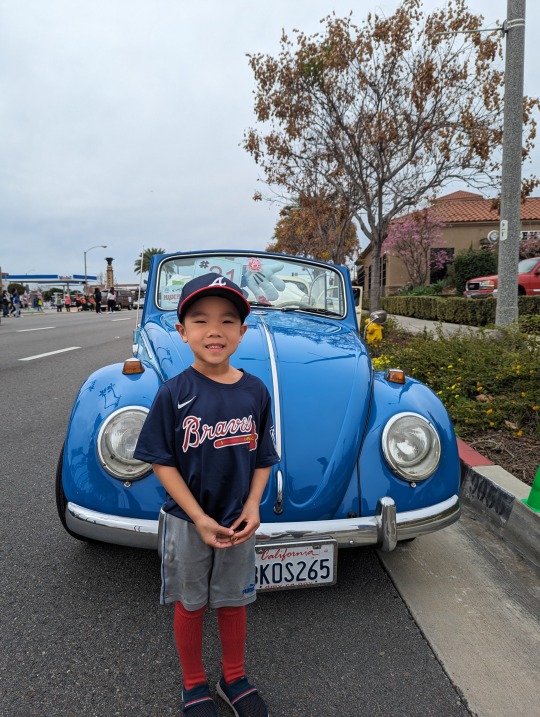
Hello everyone. I take my son to preschool everyday and currently, he really likes nursery rhymes. The Wheel On The Bus is his favorite, which means I have to play it a lot in the car, which then means that the song gets stuck in my head. I was thinking about this project while driving him to preschool and I guess the two things merged together. I changed the lyrics to The Wheel On The Bus to reflect some of the principles of microeconomics that I use in my daily life. I am not a good singer, so I forced my husband to sing what I wrote. These are the lyrics:
Incentive is something that makes people act. This concept, is not abstract.
I use it everyday with my two brats. All day long!
Whenever they do things they're supposed to do. Say thank yous, homework too.
They get tickets in which they choose to. Trade for loot!
Now my kids to not have to fight. They compromise, and specialize.
Trade has made us better off. In my eyes.
There's no such thing as free lunch. Trade tickets, for fruit punch.
You want new stuff but can't pay up. That's credit crunch.
The fancy toys cost a fortune. This is a, situation.
For my kids to think about. The margin.
At days end I am their mom. So I help, fix outcomes.
Which makes me the government. I hope I don't fail.
Wei Sun Chiu
ID: 80164694
Monday Section: 2.00-2.50PM
0 notes
Text
The Rise of Electric Vehicles: An International View on the Transition to Sustainable Mobility
Student Name: Qizhan Li
Student ID: 31807404
Student Name: Haoru Li
Student ID: 56203752
Disc: Wed 4pm

Electric vehicles in different regions of the market
During my days in California, I found electric cars on the road very common. It made me think, are electric cars better than petrol cars? When I first visited the United States in 2015, I remember there were more petrol cars. At the same time, the popularity of trams in China is not high. However, the popularity of trams may strongly affect the proportion and development of the traditional automobile industry. We are already seeing a significant increase in the availability of electric vehicles, especially in developed markets. Substantial investments by automakers are expected to meet the growing demand for electric vehicles and play an essential role in the development of the market. For example, in the market, we can see that Tesla, Volkswagen, Ford, Nissan, BMW, BYD, and Xiaopeng have invested a lot of research and development budgets for electric vehicle development. Gas-powered vehicles have caused many burdens to society, especially as a major source of urban noise and air pollution. Electric cars can avoid these problems. "Compared to internal combustion engines, electric vehicles are better for reducing emissions and human health. Transport is responsible for about 23% of global energy-related CO2 emissions. This number is expected to double by 2050" (Martin Brueckner, 2018). Leading electric vehicle markets such as China, the United States, and Germany are investing heavily in electric vehicle research and development. Indeed, there are a lot of concerns about its safety right now. However, I think electric cars may become more popular than traditional cars in the future because the main reason is environmental protection.
How does pollution as a negative explicit factor affect market supply and demand?
An externality occurs when one person' s economic activity unintentionally impacts other people. When we talk about externalities, we mean that they are being impacted directly. We want to rule out being impacted indirectly by prices.
whatever the private costs are, there is just this additional cost that society bears as a spillover during the production process. The supply curve represents the private cost. A competitive film operates under the rule that they produce up until where price equals marginal cost. So the supply curve reflects those private marginal costs. The social marginal cost line has the private cost plus the external cost to society. Thus, the market overproduces when there is a negative production externality. In this situation, with the fuel vehicles being more and more, the pollution of fuel vehicles will be released more and more. In this case, pollution as a negative production externality happens in society. It is unhealthy for the people and the world. Thus, there is a spillover cost in the market, the social marginal cost becomes bigger than before. The equilibrium price is higher and the equilibrium quantity is lower.

With the equilibrium price of traditional fuel cars is higher, the demand for these cars decreases. Also, people and government both realize that the fuel car does not work for the environment. As a result, electronic cars become popular and the demand for it become more and more. The demand curve is rightward, the quantity of demand is higher, and the price of electronic cars is higher, because of the electronic cars as the substitute of fuel cars.
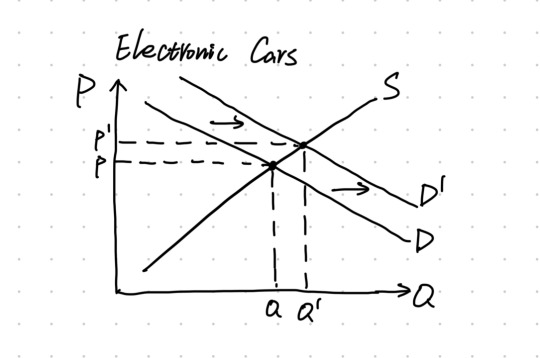
The government can opt for a Pigouvian tax, equal to the vertical difference between social and private costs, effectively eliminating externalities. Authorities may also establish a market, issuing pollution permits that act as quotas but allow firms to trade among themselves, addressing the externality more flexibly. Tradable pollution permits reduce external costs for efficient firms while imposing higher social costs on less efficient polluters. Despite facing political opposition, with some viewing quotas as inefficient and others raising ethical concerns about permits, most economists favor Pigouvian taxes to combat pollution and address climate change.
Optimal policy: tax
The problem with the negative externality is there is too much production and we know from a sales tax that sales tax will distort the market away from the equilibrium to lower production. So, we choose the tax right so there is that wedge between what buyers pay and what sellers receive so that we ended up at that socially desirable Q start level.
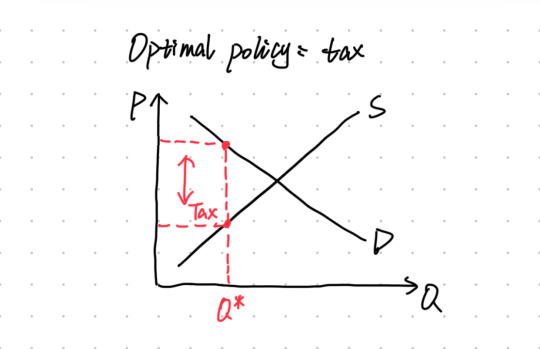
The traditional automotive sector is being significantly impacted by electric cars (EVs) not just in terms of technology and manufacturing processes but also in terms of customer behavior, market dynamics, and environmental legislation. These are a few of the principal effects:
Innovation and technology transformation: EVs are propelling traditional automakers through a significant technological transformation. As a result, businesses must spend money on battery, electric motor, and electric drivetrain research and development. Furthermore, the fields of energy storage and charging infrastructure for electric vehicles are developing quickly.
Environmental Policy and Rule Changes: Many nations have implemented policies and regulations to promote the use of electric vehicles, with the goal of lowering reliance on fossil fuels, as awareness of the need to reduce greenhouse gas emissions and protect the environment has grown globally. These policies include tax breaks and subsidies for the purchase and usage of electric vehicles, along with ever-tougher rules on emission standards for conventional vehicles.
Modifications to the market's competitive environment: The popularity of electric vehicles has brought in new rivals, like BYD and Tesla, who are concentrating on the creation and production of electric vehicles and posing a threat to established automakers' market share. Traditional manufacturers have forced to expedite the development of their own electric vehicle models in order to stay competitive.
Shifts in Consumer Behavior: As government regulations and environmental protection become more widely known, more and more people are thinking about buying electric cars. The expectations that consumers have for cars have also evolved, with an increasing focus on factors like energy economy, emissions, and intelligence.
Modifications to the supply chain and logistics: Different components and raw materials are needed for the production of electric vehicles than for traditional vehicles. For instance, there is a spike in demand for battery components like nickel, cobalt, and lithium, which has an impact on international logistics networks and supply chains. Since electric vehicles have fewer moving parts than other types of vehicles, the manufacturing process has also altered.
Requirements for energy and infrastructure have changed as a result of the widespread use of electric vehicles. Energy providers and governments are now investing more in renewable energy sources and grid infrastructure. Concurrently, the development of enough charging stations has emerged as a critical element propelling the acceptance of electric cars.
The Increase in Sales of Electric Vehicles
According to recent data, there has been a notable increase in the sales of electric vehicles, especially in the United States, where sales of EVs will surpass one million for the first time in 2023. The fact that this is a sharp rise over prior years shows how much demand there is for electric mobility options. EV sales as a percentage of new car sales in the US increased significantly from 12.9% in 2021 to 16.3% in 2022. Europe, which was the first to adopt EVs, is still in the lead thanks to its proactive regulations and financial incentives that support EVs.


Variations in the sales of electric vehicles by nation
The disparity in sales of electric vehicles among various nations can be ascribed to a confluence of factors driven by economics, technology, and policy, each of which is crucial in molding the terrain of the EV market.
Technological Developments and Economic Aspects
Thanks to technology improvements, the cost of EVs has been declining, increasing their accessibility and appeal to a larger variety of consumers. For example, in only one year (2021–2022), India's EV sales increased from 0.4% to 1.5%, demonstrating a high development rate that far above the global average. In a same vein, Israel's EV sales increased from 0.6% to 8.2% between 2020 and 2022. These instances highlight how countries who have adopted EVs more recently have been able to adopt them at faster rates thanks to declining costs and advancements in technology.
Government Policies and Incentives
EV adoption rates are significantly impacted by government interventions. For instance, the increase in EV registrations in European nations can be attributed to stimulus packages during the COVID-19 pandemic that included stronger CO2 emissions laws and more EV subsidies.
Norway serves as an excellent illustration of how government subsidies have reduced the cost of electric vehicles leading to an 80% market penetration of EVs in that nation by 2022.
China's EV development has been aided by early strategic investments, financial subsidies, and tax breaks for EV makers and consumers. The introduction of a market-based zero-emission vehicle credit program, based on California's approach, has further contributed to this change. China's focus on policies for industrial development has led to the growth of a robust local EV market that offers a wide range of models at affordable prices.
Market Dynamics
The development of the EV industry is also influenced by the state of the three largest auto markets in the world: China, Europe, and the US. China and Europe have outpaced the global average in terms of EV sales share, while the US is still a little way behind. Laws such as the US's Inflation Reduction Act are expected to stimulate significant EV investments and maybe accelerate GDP.
Europe VS Saudi Arabia
There are a number of significant reasons why EV sales in Saudi Arabia and Europe differ:
Government Policies and Incentives: To encourage EVs, European countries have implemented a number of policies, including tax breaks, subsidies, and infrastructure investments for charging stations. Saudi Arabia, on the other hand, has made less of an effort, despite growing interest in line with its Vision 2030 objectives to diversify away from oil.
Energy Costs and Oil Prices: In oil-rich regions like Saudi Arabia, the cost of oil is low, which lessens the immediate financial incentives to convert to electric vehicles. In contrast, electric vehicles are a compelling substitute due to increased fuel prices in Europe.
Compared to Saudi Arabia, Europe has a far larger network of charging stations, which increases the practicality and appeal of EVs for European consumers.
European consumers have demonstrated a strong desire for EVs, motivated by issues with urban mobility and environmental concerns. In the meanwhile, conventional tastes for big, luxurious cars could impede the adoption of EVs in areas with a lot of oil.
While EVs are often more expensive up front than their gasoline-powered counterparts, the upfront cost might be made easier by Europe's growing economy and higher average salaries.
https://www.wri.org/insights/countries-adopting-electric-vehicles-fastest
https://www.iea.org/reports/global-ev-outlook-2021/trends-and-developments-in-electric-vehicle-markets
0 notes
Text
Econ Live: Economics in Snowboard Rentals! Preferences, Opportunity Costs, and Supply/Demand.
Ryan Goldstein, ID: 38569016, Monday 3:00-3:50
Introduction:
Growing up, I loved the snow and being in the cold weather, yet living in Southern California, we didn't exactly always get that type of weather. In response to this passion, I and my family would often make trips to Big Bear and Mammoth to go snowboarding, but my parents could never bring themselves to actually buy me a snowboard.
This phenomenon brings me to the topic of economics that I would like to focus on, which is snowboard rentals (which unfortunately I am all too familiar with). We will explore my different preferences for renting different board types, the opportunity cost of renting or buying a snowboard, and how supply/demand can change for the snowboard renting market at any time.
Preferences:
Preferences are the choices individuals make based on their likes and dislikes. These preferences influence how people decide to allocate their limited resources, such as money, time, and effort, to satisfy their needs and wants. To be a rational set of preferences, two things need to be satisfied, Transitivity and Completeness. Transitivity is a logical relationship between preferences. It means that if someone prefers option A over option B, and they prefer option B over option C, then they must also prefer option A over option C. Completeness is simply the need for people to make decisions even when faced with a variety of choices.
Example:

Above is a longer snowboard that I have rented in the past made for higher speeds. All snowboard lengths are extremely important for performance, the longer the board the more stability it has at higher speeds, while the shorter the board the more control it has overall. For our situation, let's use three boards, one with control, another with speed, and the third with a mixture of speed and control.
I prefer Speed>Control, but I don't prefer Control<Mixture, yet at the end of the day I do choose Speed>Mixture.
Let's dive into whether my preferences were rational or not. We can see that they were transitive because I prefer Speed over Mixture and Mixture over control giving us Speed>Mixture>Control. Then, I was able to make complete choices, so we could scratch off completeness making my preferences completely rational!
Opportunity Costs:
Opportunity costs, often referred to as trade-offs are the value of the next best alternative that must be foregone when a choice is made. In simpler terms, it's what you give up when you choose one option over another. Every time a decision is made we are presented with these opportunity costs because there is always an opportunity not chosen, which has a cost...
Example:
Every time that I and my family made the conscious effort time and time again to rent instead of buying a snowboard we incurred an opportunity cost. Let's look exactly into what that trade-off would have been. Renting at Big Bear is approximately $45 every time you rent while buying a snowboard flat out is approximately $300 to receive a snowboard of similar or equal value. Assuming that we have gone once a year for the past eight years, we can estimate that to rent my snowboard over the years we have spent $360. This means that we have $60 of forgone expenses that we could have avoided, which is our opportunity cost. Now my family is $60 and one whole snowboard short!
Supply and Demand:
Supply and Demand are essential parts of any market, especially the snowboard rental market which we are currently looking at. Demand refers to the quantity of a good or service that consumers are willing and able to buy at various prices over a specific period. The law of demand states that all else being equal, as the price of a good or service decreases, the quantity demanded increases, and vice versa. This relationship is often depicted graphically as a downward-sloping demand curve.
Supply refers to the quantity of a good or service that producers are willing and able to offer for sale at various prices over a specific period. The law of supply states that all else being equal, as the price of a good or service increases, the quantity supplied increases, and vice versa. This relationship is typically depicted graphically as an upward-sloping supply curve. They are inversely proportional to each other and can predict how a market will act at any given time!
Example:

The graphs that can be seen above show us different scenarios that the snowboard rental market could potentially go through. To begin, we can see the first graph has some sort of tax placed on the market. Seeing that it is a tax placed on straps which has to do with production, we now know that production costs are higher which means supply will decrease, resulting in demand increasing since they are proportional. With fewer snowboards to rent and more people wanting them, the price will rise as well, creating a more expensive market for consumers and making it more expensive to rent snowboards. Let's move on to the next graph, we can see that fiberglass, a main ingredient in creating snowboards has become less expensive, which means that the production costs for snowboards have decreased, increasing the supply and decreasing the demand. Now, because there are more snowboards, but fewer people who want to buy them, they need to be sold lowering the price and making it cheaper for consumers to rent snowboards. Now that we have seen how price relates to supply and demand, I wish that the second market had been available to us these past few years!
Conclusion:
Through these examples, we can see how useful economics are in our everyday activities. Looking at the past examples, I have made sure that my preferences for snowboards are correct so I always have an enjoyable snowboarding trip. I could have saved $60 and gained a new snowboard if I had looked at my opportunity costs earlier and bought instead of renting. Lastly, I could have predicted the market by looking at supply/demand and rented/bought at the best times possible!
0 notes